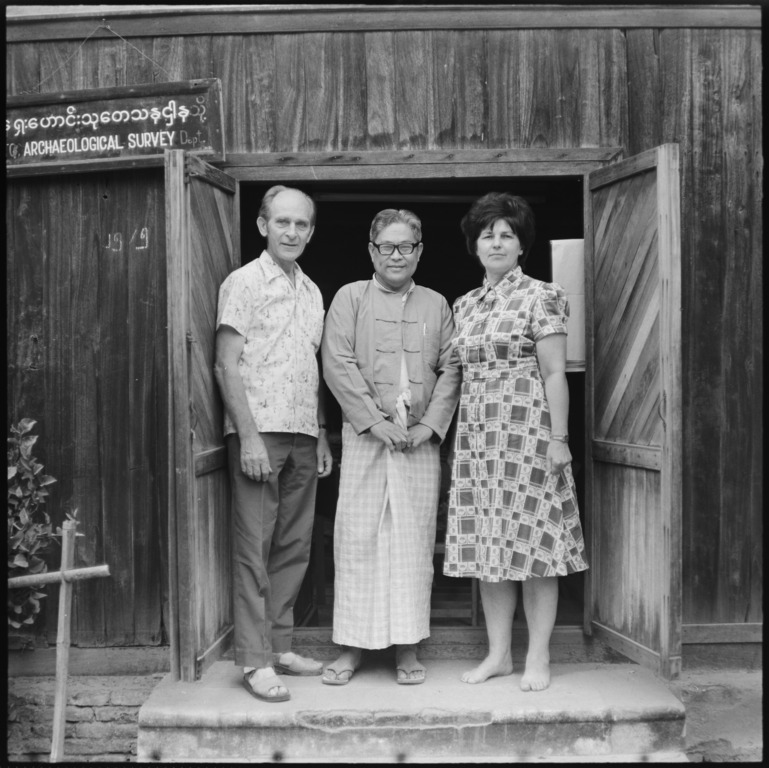Annemarie and Otto Esche
- a beacon of German Myanmar studies

I met Annemarie Esche, a doyenne of German Burma studies, in 1991 when I took up Burmese at Humboldt University in (formerly East) Berlin. After my relocation to Yangon in 1996, we met regularly when she and her husband Otto spent the wintertime there. Over time, we made friends and spent many hours together. Later, her grandson Tobias became my business partner.
Annemarie Esche was born on September 29, 1925, in Bockau near Aue in the Erzgebirge region, where she graduated from high school in 1944 and worked as a teacher for German and Russian after World War II. After studying German at the Potsdam University of Education from 1955 to 1959, she and her husband, Dr. Otto Esche, a teacher of German language and physical education, decided to work abroad in the field of German as a foreign language by order of the Herder Institute. Originally, Iraq was their desired destination, but in 1960, the institute offered them to set up the German Democratic Republic (GDR) counterpart to the already established Goethe Institute in Yangon – the ‘German Institute’. They accepted the challenge, which fundamentally changed their lives: the country fascinated them so much that Myanmar became the center of their lives.
During her work in Yangon, Annemarie Esche learned the Myanmar language so well that after her return from Myanmar in 1963, she got actively involved in setting up the new subject of Burmese Studies at the East Asian Institute of the Karl Marx University in Leipzig under the aegis of Dr. Eberhardt Richter.
She developed teaching materials, specializing in literature, culture, and language. 1968, Annemarie earned her doctorate with a dissertation on the Myanmar national poet Salay U Ponnya. The same year, she published the first collection of Myanmar short stories in German, ‘Der Markt von Pagan, Prosa aus Burma’ (The market of Pagan, prose from Burma). She translated nineteen stories from Myanmar and the Russian language into German. In the meantime, her husband had started working in the GDR Ministry of Foreign Affairs and worked at the country’s diplomatic mission in Yangon from 1969 to 1979. It allowed his wife to carry out intensive research on-site. It resulted in several publications, including the books ‘Märchen der Völker Burmas’ (Burmese fairy tales, 1976), the ‘Burmese-German Dictionary’ – the first and so far only of its kind (1976), ‘Das Goldene Kloster’ (about Mandalay’s Golden monastery, 1977), ‘Stupa Shwedagon – Das Goldene Wahrzeichen des Buddhismus in Burma’ (Stupa Shwedagon – the golden symbol of Buddhism in Burma, 1985).
After her return, she took over the management of the Burmese Studies department at the Humboldt University in Berlin, established in 1978. As was the case in Leipzig, she managed to arouse interest in the country. “I will always remember Dr. Esche being a kind, fair, charismatic, and passionate lecturer,” said one of her students at the time, looking back.
In 1978, she earned the ‘Dr.sc.’ degree (equivalent to a habilitation) with her dissertation ‘Entwicklungstendenzen der neueren burmesischen Literatur’ (Developmental trends in modern Burmese literature) and was appointed university lecturer in 1979.
Even after her retirement in 1986, she continued her involvement in her favorite subject. She supported the graduates who followed in her footsteps and enriched teaching with seminars on Buddhism and culture until the status at the institute changed fundamentally in 1994 with the introduction of a new structure. In the following period, she never stopped watching developments in Myanmar and never hesitated to represent her point of view.
Above all, she focused on her biggest project: the first German-Myanma Dictionary. It was a collaborative effort with Otto, her husband. While she was developing the lexicon, he was significantly involved in the structure of the German keywords and responsible for all technical tasks, including the digitalization of the index cards and producing the print template on an antiquated Atari (!) computer. Without the software, that is self-evident for modern lexicographers nowadays. No doubt, a Herculean task! Unfortunately, he did not live to see its publication: he died on September 6, 2010. In addition, Otto Esche was an ardent photographer. During their time in Burma/Myanmar, he took more than 10,000 photos! They deliver an insight into life in Burma during the 60s and 70s. Unfortunately, all his notes concerning those photos are lost.
From 1981 onwards, Mrs. Esche assisted the Berlin Institute’s Myanmar language lecturers as a native speaker advisor. The reunification of Germany in 1990 opened up new opportunities. A research grant from the German Research Foundation enabled her to check the equivalents on-site with various native speakers and experts from 1994 to 1996 and thus to expand the vocabulary. Until 2008, the couple spent five months a year in Myanmar working on the dictionary. 2011, the dictionary was published by Buske Verlag Hamburg. It contains around 70,000-word passages on over 1,000 pages. On this occasion, Annemarie Esche was honored with the Leibniz Medal in 2013 by the Leibniz Sozietät der Wissenschaften zu Berlin e. V. for her overall scientific achievement.
Annemarie Esche remained active well into her old age and still had plans, for example, a cultural encyclopedia of Myanmar. Even when an insidious illness gradually took away her creativity, her commitment to Myanmar remained strong, and she repeatedly warned her successor, Dr. Uta Gaertner, her first and most gifted student, to prevent the subject from disappearing in Germany. Her concerns were well-founded: the teaching of Burmese in Germany ended after the respective position holders retired in Heidelberg (1995), Göttingen (1998), and Berlin (2007). With great joy, she welcomed the news of the founding of the ‘Myanmar Institute e. V.’ association. A promise that the Myanmar studies, her lifetime achievement, was given a future in her country of birth. She died on July 13, 2018, in Berlin.